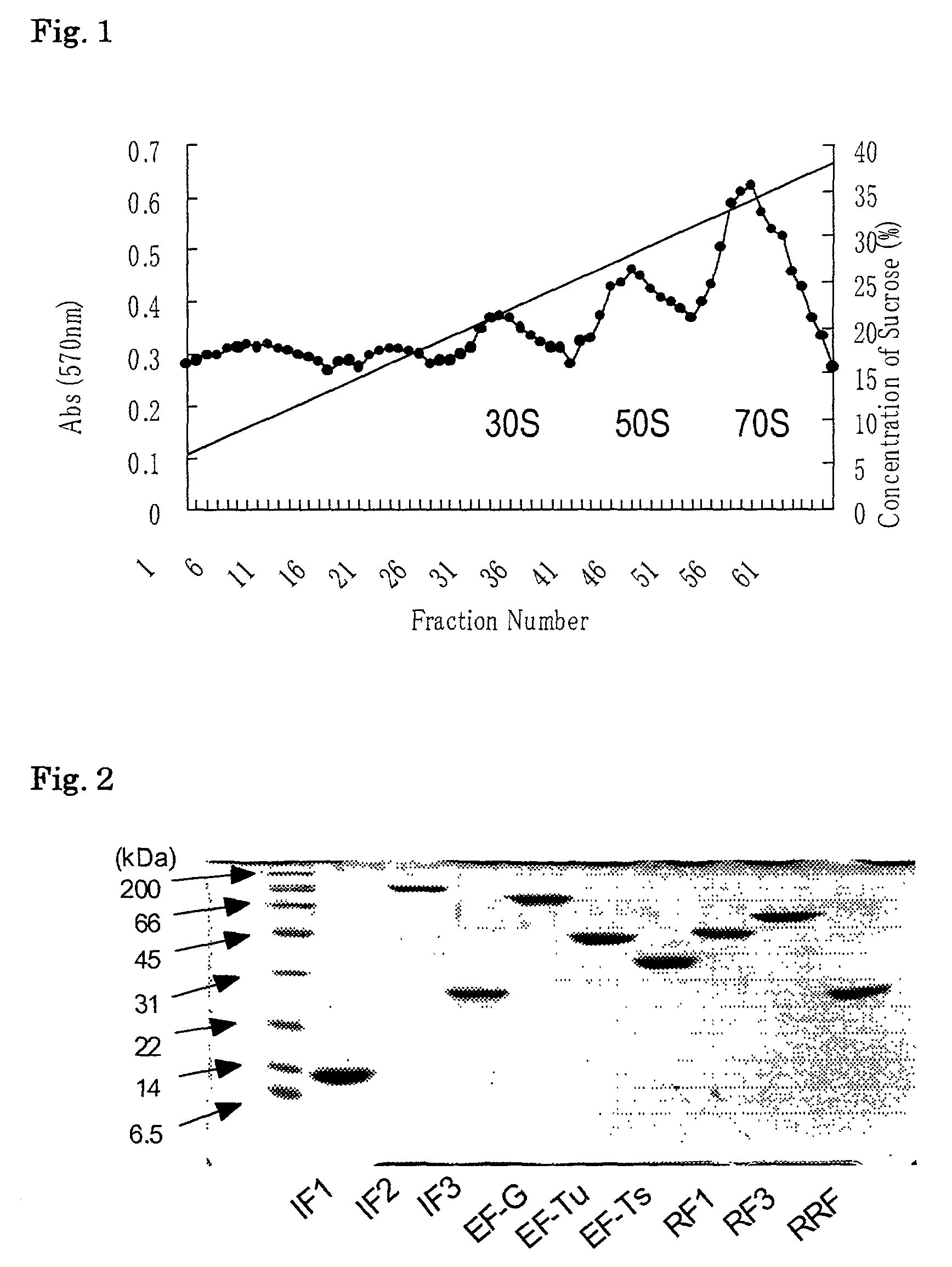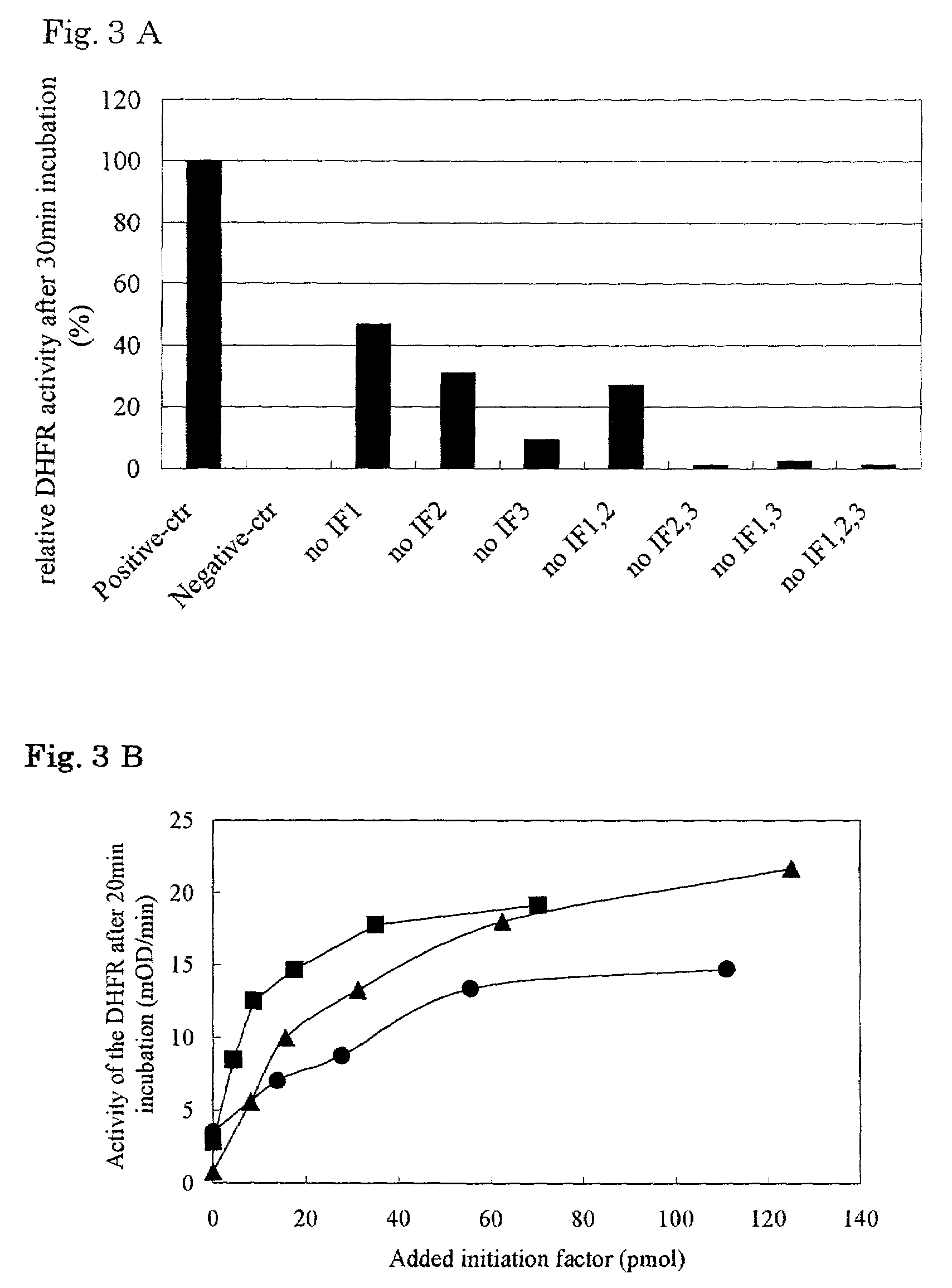Process for producing peptides by using in vitro transcription/translation system
a transcription/translation system and peptide technology, applied in the direction of peptides, enzymology, transferases, etc., can solve the problems of inability to perform stable reactions, peptides were synthesized only at low yield, and reaction energy consumption, and achieve efficient isolation from the reaction system. high purity
- Summary
- Abstract
- Description
- Claims
- Application Information
AI Technical Summary
Benefits of technology
Problems solved by technology
Method used
Image
Examples
example 1
Preparations of E.coli Ribosome and Extraction of S100
[0216]300 g of E.coli A19 cells (harvested at mid-log phase) were ground with alumina. The ground cells were suspended in buffer A (10 mM Hepes-KOH (pH7.6), 10 mM MgCl2, 50 mM KCl, 1 mM DTT) and alumina and cell debris were eliminated by centrifugation at 30,000 g for 1 h at 4° C. DNase (deoxyribonuclease) was added to the resultant supernatant fraction to give a final concentration of 1 μg / ml followed by centrifugation at 100,000 g for 4 h at 4° C. The supernatant fraction thus obtained was referred to as S100. The pellet was resuspended in the buffer A and the resultant suspension was referred to as a crude ribosome extract. From this crude ribosome extract, a tight-coupled ribosome fraction was obtained under a sucrose density gradient of 6 to 36%. This tight-coupled ribosome fraction was centrifuged at 100,000 g and the pellet was suspended in ribosome buffer (20 mM Hepes-KOH (pH7.6) 6 mM MgOAc, 30 mM NH4Cl 7 mM β-mercaptoeth...
example 2
Construction of Plasmids for Overexpressing Initiation Factors, Elongation Factors and Termination Factors
[0217]Using E. coli A19 genome as a template, a gene sequence encoding EF-Tu gene was amplified by PCR to give a DNA fragment having an EcoRI-recognition sequence at the 5′ terminus and a BglII-recognition sequence at the 3′ terminus. The DNA fragment thus obtained was inserted into a plasmid pQE60 (QIAGEN) which had been cleaved with EcoRI and BglII. Thus, a vector for overexpressing EF-Tu fused with His tag at the C terminus was constructed. Next, E. coli BL21 / pREP4 was transformed by the vector obtained above. Vectors for overexpressing other elongation factors, initiation factors and termination factors were constructed in the same manner. Table 1 summarizes the vectors and restriction enzymes employed and the His tag sites.
example 3
Construction of Plasmids for Overexpressing Aminoacyl-tRNA Synthetase (ARS) and Methionine-tRNA Formylase (MTF)
[0218]Using E. coli A19 genome as a template, a gene sequence encoding alanyl-tRNA synthetase gene was amplified by PCR to give a DNA fragment having an SphI-recognition sequence at the 5′ terminus and a HindIII-recognition sequence at the 3′ terminus. The DNA fragment thus obtained was inserted into a plasmid pQE30 (QIAGEN) which had been cleaved with SphI and HindIII. Thus, a vector for overexpressing alanyl-tRNA synthetase fused with His tag at the N terminus was constructed. Next, E. coli BL21 / pREP4 was transformed by the vector obtained above. Vectors for overexpressing other ARS and MTF were constructed in the same manner. Table 1 summarizes the vectors and restriction enzymes employed and the His tag sites, wherein the plasmids obtained were transformed into E.coli BL21 / pREP4(pQE series) or BL21 / DE3(pET series) strain.
[0219]
TABLE 1Enzymessiteor factorsvectorN-termina...
PUM
| Property | Measurement | Unit |
|---|---|---|
| pH | aaaaa | aaaaa |
| concentration | aaaaa | aaaaa |
| pH | aaaaa | aaaaa |
Abstract
Description
Claims
Application Information
 Login to View More
Login to View More - R&D
- Intellectual Property
- Life Sciences
- Materials
- Tech Scout
- Unparalleled Data Quality
- Higher Quality Content
- 60% Fewer Hallucinations
Browse by: Latest US Patents, China's latest patents, Technical Efficacy Thesaurus, Application Domain, Technology Topic, Popular Technical Reports.
© 2025 PatSnap. All rights reserved.Legal|Privacy policy|Modern Slavery Act Transparency Statement|Sitemap|About US| Contact US: help@patsnap.com



